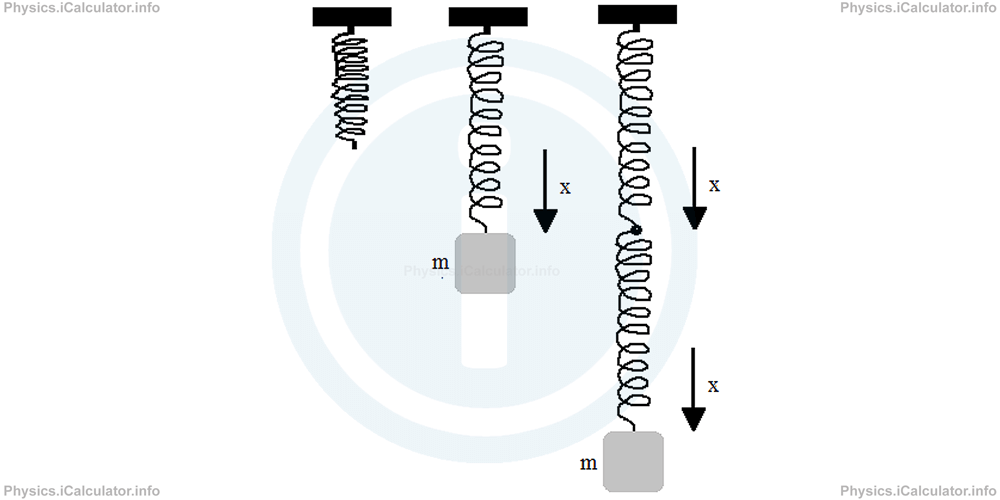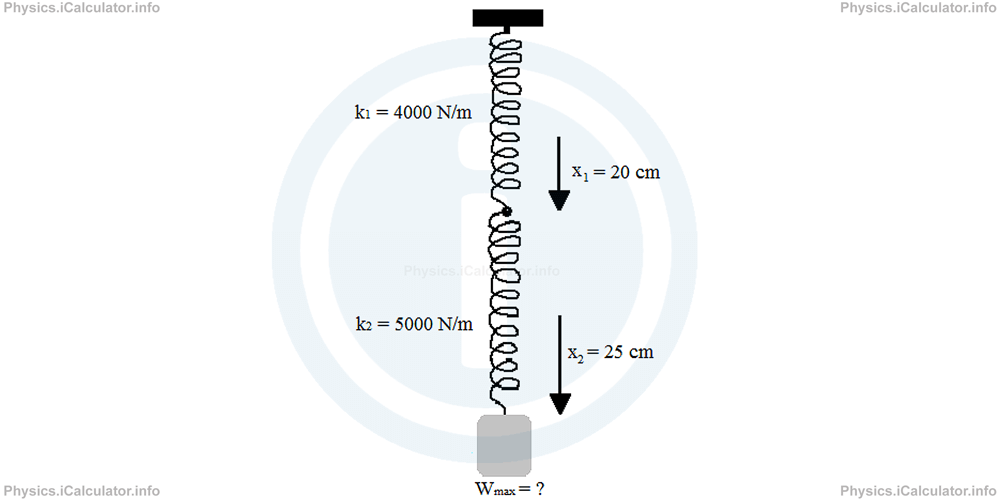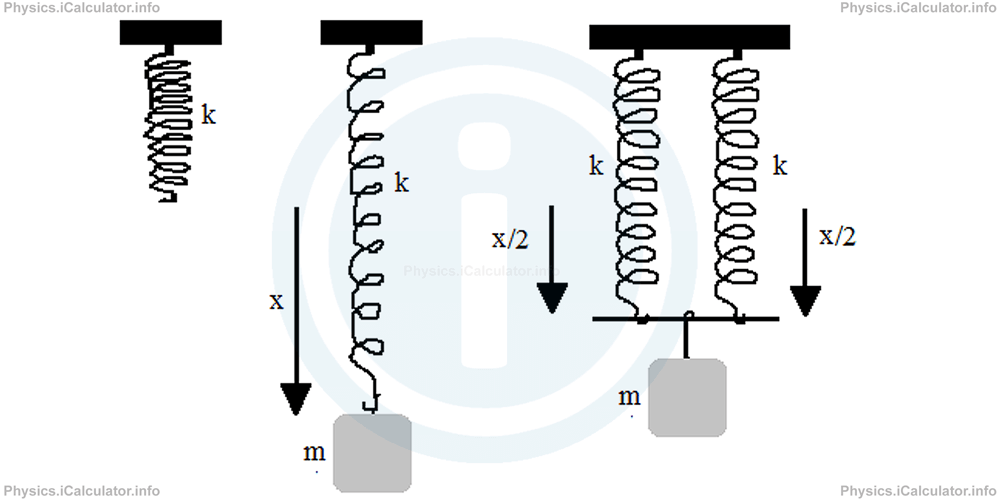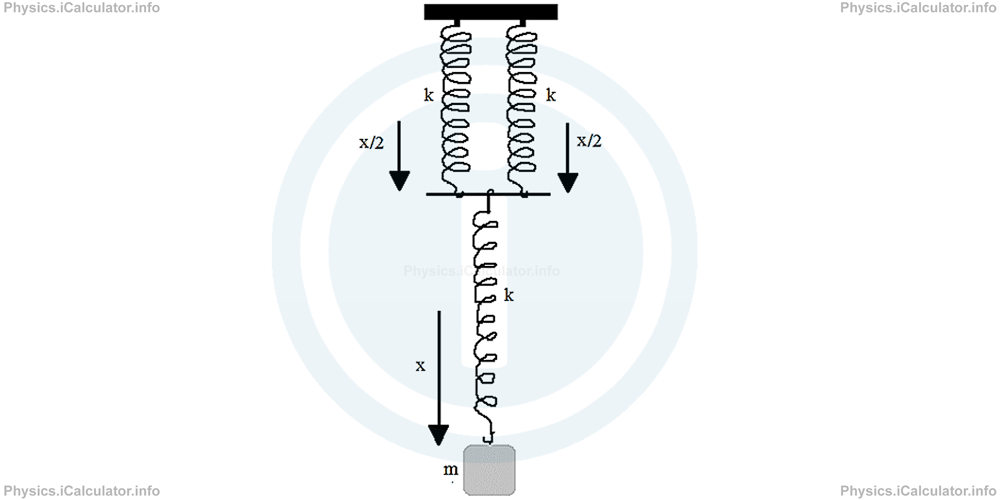Menu
Physics Lesson 5.4.3 - Combination of Springs
Please provide a rating, it takes seconds and helps us to keep this resource free for all to use
Welcome to our Physics lesson on Combination of Springs, this is the third lesson of our suite of physics lessons covering the topic of Elastic Potential Energy and Combination of Springs, you can find links to the other lessons within this tutorial and access additional physics learning resources below this lesson.
Combination of Springs
The large value of spring constant obtained in the previous exercise, means the spring is very stiff and therefore, it can store a lot of elastic energy when stretched or compressed in maximum.
To change the level of stiffness in springs, we can combine two or more spring in two basic ways:
a. In series
In this combination, the springs are placed one after another. As a result, when we hang an object on such a system, it pulls each spring if there was only one spring available. Therefore, the same weight causes a double extension in the system composed by two springs in series than if it was one spring only. Look at the figure below. For simplicity, the springs are taken as identical, i.e. they have a constant k each.

Since there is the same force F = m × g that acts in both cases, we have for the single spring system:
and for the double spring system:
= F/2x
= k1/2
This allows us to find a formula for the spring constant ks in series combination of springs. It is
where k1 and k2 are the constants of each spring respectively.
This rule can also extend for a system composed by more than two springs or when the springs are not identical, i.e. when their individual constants are different.
Example 3
Two springs are combined in series as shown in the figure. The maximum extension of each spring without losing the elastic properties is 20 cm and 40 cm respectively.
- What is the spring constant of this combination if the constant of the first spring is 4000 N/m and that of the second spring is 5000 N/m?
- What is the maximum weight they can hold in such a combination?

Solution 3
- Using the formula for the series combination of springs, we obtain
= 1/4000 + 1/5000
= 5/20000 + 4/20000
= 9/20000
Therefore,
- We must find the maximum weight each spring can hold and then, considering only the smallest value from the two. We have:
= 4000 N/m × 0.2 m
= 800 N
and
= 5000 N/m × 0.25 m
= 1250 N
Therefore, the system can hold 800 N at maximum so that both springs preserve their elastic properties.
Remark! Series combination of springs is usually applied when the springs available are stiffer than needed because combining two springs in series reduces the stiffness of the system, making it more elastic.
b. In Parallel
When two or more springs are connected in parallel, they distribute the load amongst them and as a result, they will extend less than if there was only one spring available. Such a combination creates a system of springs with a higher stiffness. The equation for the spring constant of the system of two parallel springs is
where kp is the spring constant of the parallel setup, while k1 and k2 are the constants of the individual springs.
In other words, if a single spring with constant k stretches by x units when an object m is hanged on it, then when we use two springs of this kind connected in parallel to hang the same object, they will extend by x/2 because the stiffness of the system increases by a factor of two. As a result, it can store double of energy it could store when a single spring was used. Look at the figure.

Example 4
Two identical springs by constants 2000 N/m each, are combined in parallel.
- What is their extension when a 50 kg object is hanged on them?
- What is the amount of energy stored in the springs?
For simplicity, take g = 10 N/kg.
Solution 4
We can take the figure shown above in theory as a reference. First, we must calculate the constant of the parallel system of springs. We have
= k + k
= 2k
= 2 × 2000 N/m
= 4000 N/m
a. The force caused in this system of spring is equal to the weight of the hanged object. Thus,
= 50 kg × 10 N/kg
= 500 N
Therefore, the extension of the parallel system of springs is
= 500 N/4000 N/m
= 0.125 m
= 12.5 cm
b. The energy stored in this system of springs is calculated through the formula of elastic potential energy. We have:
= 4000 N/m × (0.125 m)2/2
= 31.25 J
Remark! The energy stored in this system of springs is different (is smaller) than if only one spring was used. Indeed, for the same force, if we had only one spring the extension would be
As a result, the energy stored in this spring would be
= 2000 × 0.252/2
= 62.5 J
As you see, the energy stored is double of the one stored in the parallel setup, confirming the theory explained earlier.
c. Mixed combination of springs
In this case, we start by calculating the constant of the parallel part and then, we think as having a single spring in that part. It is combined in series with the rest of the springs to get the total spring constant of the entire system. Look at the figure:

For simplicity, we will consider only identical springs. If the mass of the springs and the support are not considered, there is only one force acting on the system. It is the object's weight. Therefore, the constants will be 2k for the parallel part and k for the lower spring, which is in series with the other two. As a result, the total spring constant of the system is
= 1/2k + 1/k
= 1/2k + 2/2k
= 3/2k
Therefore,
As for the total extension of the system, we have
= x/2 + 2x/2
= 3x/2
You have reached the end of Physics lesson 5.4.3 Combination of Springs. There are 3 lessons in this physics tutorial covering Elastic Potential Energy and Combination of Springs, you can access all the lessons from this tutorial below.
More Elastic Potential Energy and Combination of Springs Lessons and Learning Resources
Whats next?
Enjoy the "Combination of Springs" physics lesson? People who liked the "Elastic Potential Energy and Combination of Springs lesson found the following resources useful:
- Springs Feedback. Helps other - Leave a rating for this springs (see below)
- Work, Energy and Power Physics tutorial: Elastic Potential Energy and Combination of Springs. Read the Elastic Potential Energy and Combination of Springs physics tutorial and build your physics knowledge of Work, Energy and Power
- Work, Energy and Power Revision Notes: Elastic Potential Energy and Combination of Springs. Print the notes so you can revise the key points covered in the physics tutorial for Elastic Potential Energy and Combination of Springs
- Work, Energy and Power Practice Questions: Elastic Potential Energy and Combination of Springs. Test and improve your knowledge of Elastic Potential Energy and Combination of Springs with example questins and answers
- Check your calculations for Work, Energy and Power questions with our excellent Work, Energy and Power calculators which contain full equations and calculations clearly displayed line by line. See the Work, Energy and Power Calculators by iCalculator™ below.
- Continuing learning work, energy and power - read our next physics tutorial: Power and Efficiency
Help others Learning Physics just like you
Please provide a rating, it takes seconds and helps us to keep this resource free for all to use
We hope you found this Physics lesson "Elastic Potential Energy and Combination of Springs" useful. If you did it would be great if you could spare the time to rate this physics lesson (simply click on the number of stars that match your assessment of this physics learning aide) and/or share on social media, this helps us identify popular tutorials and calculators and expand our free learning resources to support our users around the world have free access to expand their knowledge of physics and other disciplines.